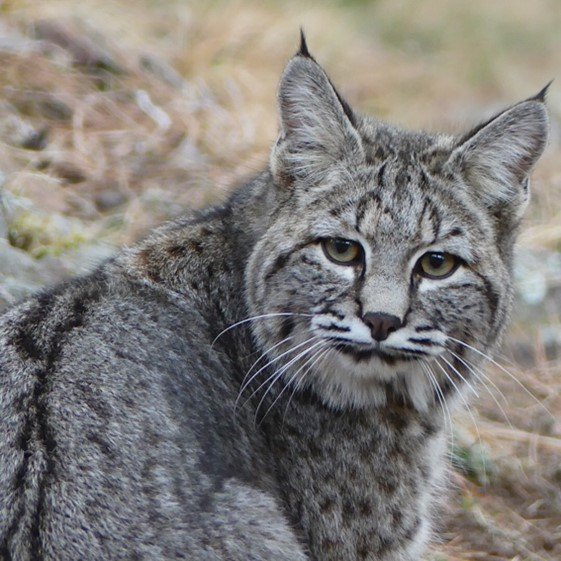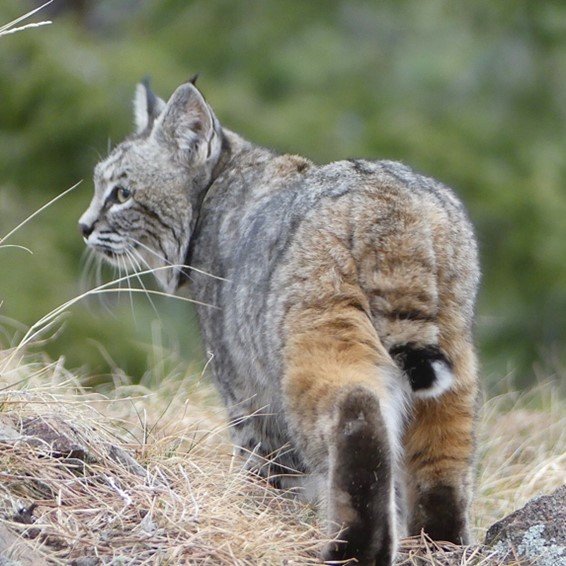Boulder Bobcats
By Carron Meaney
Many people get excited about mountain lions, but you may want to keep your eyes peeled to see a bobcat. These magnificent cats, named for their bobbed tail, are among us but are very shy and secretive. We don’t see them that often.
Much of Boulder County provides good habitat for them. They typically prefer rocky areas and dense vegetation with good cover, such as in riparian areas. Within the desirable habitat, they change their specific shelter/resting sites frequently. Shelters or day beds include hollow logs, rocky areas, caves, low tree branches, other covered shelter, and even the top of a Saguaro cactus (but not in Boulder)! They are good swimmers and can leap up to 10 feet in the air. Their tracks are round with 4 toes and no claws, about 1.5 to 2.5 inches across.
Bobcat in fresh fall/winter coat with gray coloring. They do have ear tufts, but much smaller than lynx ear tufts. Photo by Susan Schiff.
Males bobcats are larger than females. Bobcats molt in the fall to a generally grayish color in winter. By summer their coat has worn down and shows as more red. They have a tail with a black tip on the top, white on the underside.
This animal is sporting a worn-down summer coat. Note the white on the underside of the tail. Photo courtesy of Carron Meaney, original photographer a Pine Brook Hills resident.
Bobcats prey on cottontail rabbits and woodrats, and will take any prey item they can catch including mice, chipmunks, ground squirrels, and small birds. They also prey on turkeys and an occasional housecat! They are strict carnivores and, unlike foxes and coyotes, do not eat plant material.
Bobcats make many different sounds: something that sounds like “RAW”, growls, roars, and screeches or eerie screams.
Bobcats occur throughout Colorado. In contrast, the lynx occurs only above 10,000 feet, has huge paws, and has a tail with a black tip on top and bottom.
The bobcat’s tail is black on top and white on the underside. Lynx have black-tipped tails with black on top and bottom. Photo by Susan Schiff.
Female bobcats are seasonally polyestrous: they come into estrus for breeding during February to March, and do so repeatedly until they breed. They ovulate spontaneously, unlike domestic cats in which ovulation is induced (house cats ovulate in response to male attention). They typically have one litter per year. Females have litters of 2 to 3 kittens after a gestation of about 65 days and the kittens will stay with the female for 7 to 12 months before dispersing on their own.
Bobcats reach sexual maturity in their second year. Bobcats defend territories, and scent mark with urine and feces. The territories of males can overlap with other males, while the smaller territories of females do not overlap with other females. Bobcats are solitary except during the breeding season (pairs) and while the female has young (female and offspring).
A 2010-2012 study, by Jesse Lewis at Colorado State University, found that some males traveled surprisingly large distances. One male traveled from the city of Boulder all the way to the Continental Divide and then later returned. Typical daily movements in Colorado are half a mile to 2 miles.
It is thought that some populations in Colorado were over-harvested until leg-hold traps were banned in 1997. Since then, they seem to be doing well.
This bobcat is part of a research study, note the ear tag. Photo by Susan Schiff.




